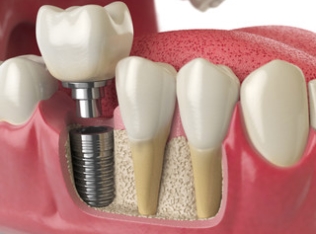Your Single Tooth Implant
According to the American Dental Association

If you are missing a tooth, there are many reasons to replace it:
- Missing teeth may affect the way you speak and chew.
- If a missing tooth is not replaced, the teeth around it can move. This can affect your bite and place more stress on your teeth and jaw joints.
- Teeth that have tipped or drifted are also harder to clean. This puts them at a higher risk for tooth decay and gum disease.
- Bone loss can occur around the missing tooth.
- You may not like the way a missing tooth affects your looks.

Position of teeth immediately after a tooth is lost.

If the tooth is not replaced, other teeth can drift out of position and change the bite.
A dental implant is the next best thing to the real thing.
Nothing replaces your natural teeth, but dental implants can come close. Implants have been used for many years. They are man-made “anchors” that look like screws and are made of titanium and other materials that are compatible with the human body. The single tooth implant is placed by surgery in the upper or lower jaw, where it replaces your missing tooth’s root(s).
An implant looks and acts like a natural tooth. It fits securely even when you chew and speak. A single tooth implant does not involve treatment to your other teeth. Plus, it may also help you keep a good level of bone around your teeth.
Steps of placing an implant
The way implants are placed depends on your anatomy or bone structure, the type of implant, and the tooth being replaced. Some implants require 2 or 3 appointments and can take up to a year to complete. Other implants can have a temporary crown placed on the same day. You and your dentist can discuss which type is best for you.
Most implants involve 3 or 4 basic steps:
Placement of the implant
Your dentist surgically places the implant into your jawbone. There may be some swelling and/or tenderness after the surgery, so pain medication may be prescribed to ease the discomfort. Your dentist may recommend a diet of soft foods during the healing process.
The healing process
What makes an implant so strong is that the bone actually grows around it and holds it in place. This process is called osseointegration (OSS-eo-in-tee-GRAY-shun) and takes time. Some people might need to wait until the implant is completely integrated before a permanent replacement tooth can be attached to the implant. This can take several months. Other people can have the implant and a temporary replacement tooth placed all in one visit. The length of the healing process depends on location of the replacement tooth and the type of implant being used.
Replacing your missing tooth
For a single tooth implant, your dentist custom-makes a new tooth for you, called a dental crown. It is based on a size, shape, and color that will blend with your other teeth. Once completed, the man-made tooth is attached to the implant post or abutment.
Are you a good candidate for an implant?
Your dentist can help you decide if you can get a dental implant. In most cases, you are a good candidate if:
- you are in good general health. Some chronic illnesses may slow healing after surgery and prevent successful placement of an implant.
- you have a jawbone that can support an implant. If you have lost bone in your jaw you may still get an implant. Sometimes bone must be added by a special process known as bone grafting.
- you don’t use tobacco in any form. Smoking or chewing tobacco may be linked to a higher rate of implant failure.
Good oral hygiene is very important to the success of your implant.
You’ll need to make sure the area around the implant is especially clean. Your dentist may recommend that you use a special toothbrush, called an interproximal brush, or a mouthrinse to help prevent gum problems.
You should also choose oral care products with the American Dental Association Seal of Acceptance. A product that displays the ADA Seal is your assurance that it has met ADA standards for safety and effectiveness. All of these accepted products will help ensure the area around your implant remains healthy.
This ADA educational message displayed by permission.



